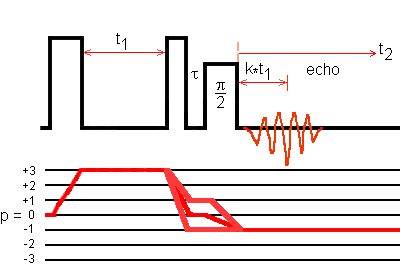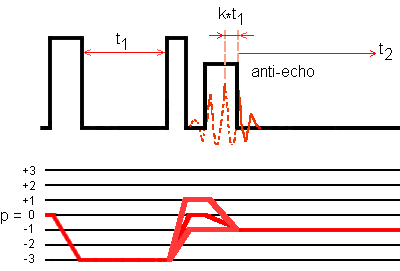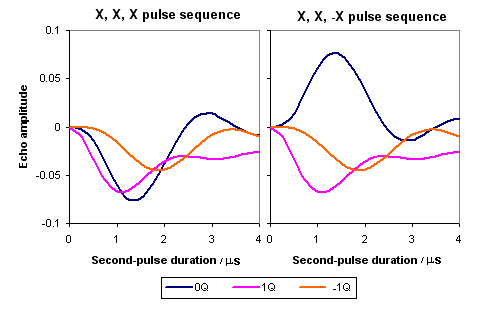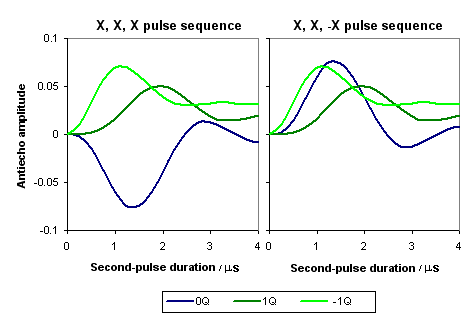Soft Pulse Added Mixing MQMAS
AIM: We provide Mathematica-5 notebooks and SIMPSON1.1.1 Tcl scripts to optimize the amplitude of the echo and that of the antiecho in SPAM MQMAS NMR applied to half-integer quadrupole spin according to the phase (X or -X) of the third or soft pulse.
Z. Gan and H.-T. Kwak [Enhancing MQMAS sensitivity using signals from multiple coherence transfer pathways, J. Magn. Reson. 168, 346-351 (2004)] present the SPAM approach to enhance the MQMAS NMR sensitivity of half-integer quadrupole spins using three coherence transfer pathways for the echo and for the antiecho signals.

Fig. 1: SPAM echo transfer pathways for a spin I = 5/2 system.

Fig. 2: SPAM antiecho transfer pathways for a spin I = 5/2 system.
Method: We simulate the echo and the antiecho amplitudes of a spin I = 5/2 with increasing second-pulse duration in a powder rotating at the magic angle, using Mathematica-5 notebooks and SIMPSON1.1.1 Tcl scripts. The six coherence transfer pathways are simulated with phases X and -X for the third or soft pulse.
The parameters for these simulations are:
- Nucleus: 27Al
- Spin: 5/2
- 27Al Larmor frequency: 208.61889974 MHz
- Proton Larmor frequency: 800 MHz
- Only 3Q and -3Q coherences belonging to the second diagonal of the density matrix are taken into account for the simulation
- Amplitude of the strong radio-frequency pulse: 90 kHz
- Amplitude of the weak radio-frequency pulse: 9.3 kHz
- First-pulse duration: 4 μs
- Initial duration of the second pulse: 0
- Final duration of the second pulse: 4 μs
- Pulse duration increment: 0.25 μs
- Number of the second-pulse duration increment: 17
- Third-pulse duration: 9 μs
- Rotor spinning speed: 5 kHz
- Quadrupole interaction: first and second orders
- Quadrupole coupling constant: 5 MHz
- Asymmetry parameter: -1 for notebook and 1 for Tcl script
- Crystal file: rep100_simp for notebook and rep100.cry for Tcl script
- Number of summation steps of the Euler angle γ of the rotor: 10
(A) Mathematica-5 notebook
(1) Preliminary
| Coherence transfer pathway |
X, X, X sequence notebook |
X, X, -X sequence notebook |
|---|---|---|
| 0Q->3Q->1Q->-1Q | spam_P2 (pdf) |
spam_P2 (pdf) |
| 0Q->3Q->0Q->-1Q | spam_P2 (pdf) |
spam_P2 (pdf) |
| 0Q->3Q->-1Q->-1Q | spam_P2 (pdf) |
spam_P2 (pdf) |
| 0Q->-3Q->1Q->-1Q | spam_P2 (pdf) |
spam_P2 (pdf) |
| 0Q->-3Q->0Q->-1Q | spam_P2 (pdf) |
spam_P2 (pdf) |
| 0Q->-3Q->-1Q->-1Q | spam_P2 (pdf) |
spam_P2 (pdf) |
- Download the twelve Mathematica-5 notebooks, that for MAS NMR utilities QUADRUPOLE_1_0.nb (the corresponding PDF file), and the crystal file rep100_simp.
- Save these files into the software Mathematica-5 folder. Forbidden the Operating System of your computer to include extra file extension to rep100_simp by providing the file name with double quotes such as "rep100_simp".
- Open QUADRUPOLE_1_0.nb file with Mathematica-5.
- Press "Ctrl-A" to select the notebook, then press "Shift-enter" to start the notebook. (Some warning messages appear but they have no consequences on the results.) A file called QUADRUPOLE is created in Mathematica-5 folder.
(2) Simulation
- Open a simulation file such as spam_P2_3Q1Qxxx.nb with Mathematica-5.
- Press "Ctrl-A" to select the notebook, then press "Shift-enter" to start simulation. (Some warning messages precede the simulation.) After the simulation a data file, called spam_P2_3Q1Qxxx, is created in Mathematica-5 folder. MS Excel can open this data file for graphic representation.
(B) SIMPSON1.1.1 Tcl script
(1) Preliminary
| Coherence transfer pathway |
X, X, X sequence Tcl script |
X, X, -X sequence Tcl script |
|---|---|---|
| 0Q->3Q->1Q->-1Q | spam_p2 | spam_p2 |
| 0Q->3Q->0Q->-1Q | spam_p2 | spam_p2 |
| 0Q->3Q->-1Q->-1Q | spam_p2 | spam_p2 |
| 0Q->-3Q->1Q->-1Q | spam_p2 | spam_p2 |
| 0Q->-3Q->0Q->-1Q | spam_p2 | spam_p2 |
| 0Q->-3Q->-1Q->-1Q | spam_p2 | spam_p2 |
Download and save these twelve files into the software SIMPSON1.1.1 folder.
(2) Simulation
Run a SIMPSON1.1.1 Tcl script file such as spam_p2_3Q1Qxxx.in in a DOS window. The simulated signal amplitudes are saved in the file called spam_p2_3Q1Qxxx.fid in SIMPSON1.1.1 folder. MS Excel also can open this data file for graphic representation.
(C) Result
Figures 3 and 4 represent the twelve simulated data. Notebooks and Tcl scripts provide the same data.

Fig. 3: 27Al SPAM 3Q-echo amplitudes obtained
with X, X, X pulse sequence (left-hand side) and with X, X, -X pulse sequence
(right-hand side) versus the second-pulse duration for the three coherence
0transfer pathways.
0Q curve for coherence transfer pathway
0Q->3Q->0Q->-1Q;
±1Q curve for coherence transfer pathway 0Q->3Q->±1Q->-1Q.

Fig. 4: 27Al SPAM -3Q-antiecho amplitudes obtained
with X, X, X pulse sequence (left-hand side) and with X, X, -X pulse sequence
(right-hand side) versus the second-pulse duration for the three coherence
transfer pathways.
0Q curve for coherence transfer pathway
0Q->-3Q->0Q->-1Q;
±1Q curve for coherence transfer pathway
0Q->-3Q->±1Q->-1Q.
For a given pulse sequence (X, X, X or X, X, -X), the 0Q curve describing the echo amplitude and that describing the antiecho amplitude have the same sign. In contrast, the ±1Q curves describing the echo amplitude and those describing the antiecho amplitude have opposite signs
Alternating the phase of the third or soft pulse
- changes the sign of the echo amplitude and that of the antiecho associated with 0Q->3Q->0Q->-1Q and 0Q->-3Q->0Q->-1Q coherence transfer pathways;
- but does not change the sign of the echo amplitudes and those of the antiecho associated with 0Q->3Q->±1Q->-1Q and 0Q->-3Q->±1Q->-1Q coherence transfer pathways.
For a given phase (-X or X) of the third or soft pulse
- the echo and the antiecho associated with 0Q->3Q->0Q->-1Q and 0Q->-3Q->0Q->-1Q coherence transfer pathways have the same amplitude;
- but the echo and the antiecho associated with 0Q->3Q->±1Q->-1Q and 0Q->-3Q->±1Q->-1Q coherence transfer pathways have almost opposite amplitudes.
(D) Conclusions
- The highest sensitivity enhancement in SPAM 3QMAS sequence is obtained with an X phase for the third or soft pulse.
- On the other hand, the highest sensitivity enhancement in SPAM -3QMAS sequence is obtained with a -X phase for the third or soft pulse.
- Therefore, when the echo signal and that of the antiecho are acquired separately, the echo amplitude and the antiecho amplitude have opposite signs.
These results are in agreement with those of J.-P. Amoureux and coworkers, [Increasing the sensitivity of 2D high-resolution NMR methods applied to quadrupolar nuclei, J. Magn. Reson. 172, 268-278 (2005)].
We provide notebooks and SIMPSON1.1.1 Tcl scripts for these two cases. They allow us to optimize the echo amplitude and that of the antiecho using each of the three pulses:
| SPAM | Notebook | SIMPSON1.1.1 Tcl script |
|---|---|---|
| 3QMAS | P1_3Qxxx.nb (pdf) | p1_3Qxxx.in |
| P2_3Qxxx.nb (pdf) | p2_3Qxxx.in | |
| P3_3Qxxx.nb (pdf) | p3_3Qxxx.in | |
| -3QMAS | P1_-3Qxx-x.nb (pdf) | p1_-3Qxx-x.in |
| P2_-3Qxx-x.nb (pdf) | p2_-3Qxx-x.in | |
| P3_-3Qxx-x.nb (pdf) | p3_-3Qxx-x.in |
We also provide notebooks and SIMPSON1.1.1 Tcl scripts as above files, but all the coherences belonging to the same MQ coherence transfer pathway are considered:
| SPAM | Notebook | SIMPSON1.1.1 Tcl script |
|---|---|---|
| 3QMAS | P1_3QxxxS.nb (pdf) | p1_3QxxxS.in |
| P2_3QxxxS.nb (pdf) | p2_3QxxxS.in | |
| P3_3QxxxS.nb (pdf) | p3_3QxxxS.in | |
| -3QMAS | P1_-3Qxx-xS.nb (pdf) | p1_-3Qxx-xS.in |
| P2_-3Qxx-xS.nb (pdf) | p2_-3Qxx-xS.in | |
| P3_-3Qxx-xS.nb (pdf) | p3_-3Qxx-xS.in |
Nicolas Malicki and coworkers [Multiplex MQMAS NMR of quadrupolar nuclei, Solid State Nucl. Magn. Reson. 28, 13-21 (2005)] present the Multiplex SPAM approach which reduces the experimental time considerably.
